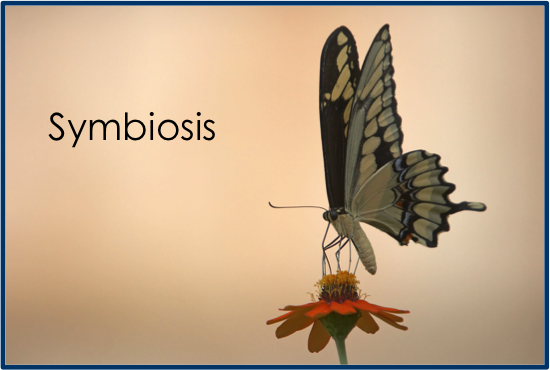By Michelle Reeb, The Marketer Network
The butterfly and the flower thrive because of each others’ existence. While the butterfly drinks a flowers’ nectar, it transfers pollen from flower to flower which produce seeds that kick-start the process of new life for the flowers. Together their ecosystems flourish.
Just as in nature, the relationship between businesses and their customers is symbiotic, where both the company and customer benefit from one another.
The customer relationship is just one element of a business ecosystem, but it is one of the most important. By understanding what motivates your customer, you’re better poised to meet their needs to drive their success (and yours).
To make the biggest impact with your marketing investment, consider a focus on developing tight-knit relationships with your customers. Start by gaining a deep understanding of your customer: what is important to them – what drives their success – how you contribute to their success.
Symbiosis Defined:
“A mutually beneficial relationship between different people or groups.”
-OxfordDictionaries.com
What is your relationship with your customers?
Do you know their pain points? Are they better off because of you? Do they like working with you? Do they want to see you succeed as much as you want to see them succeed? Oftentimes, the answer is no to one or all of these questions. But what if the answers were all YES? What would the result be on your business?
Getting to YES!
In business, symbiotic relationships go well beyond a buy/sell arrangement; they are a function of business value for your customers and yourself. Think of them as collaborative partnerships built on trust, support and dependence, which provide mutual benefit and which continue indefinitely.
Profile of a Buy / Sell Relationship
A business develops useful products and services. Customers buy those products and services because they value the offering. The results, revenue for the business and a happy customer.
But it doesn’t have to end here.
Profile of a Symbiotic Relationship
If only a business understood its customer better, what would result? Better offerings? Laser focus on investments in R&D and marketing? Enriched customer commitment and loyalty? Increased revenue? Fulfilling relationships that make our jobs more fun and enjoyable in an environment based on service and success?
Businesses fostering symbiotic relationships are concerned about the positive impact they are contributing to the success of those they serve.
How about you? What changes would you make if you understood the impact you have on the success of your customers? Building a thriving symbiotic relationship is a journey of the ins and outs of your business.
THERE ARE 3 STEPS TO DEVELOPING SYMBIOTIC RELATIONSHIPS
Step 1: Introspection (Know Thyself)
- Why does our business exist?
- What do we care about?
- What inspires us?
- What are we best at?
- What makes us unique?
Step 2: Outward Perspective (Know Thy Customer)
- Who do we serve?
- What’s important to them?
- What’s our likeability in our customers’ eyes?
Step 3: Creating The Ultimate Customer Experience
- How do we engage those we serve?
- How are we contributing to their success?
- Is our relationship poised for lifelong sustainability?
- Are they as thrilled about our success as we are with theirs?
Serendipity Strikes!
And the world would be perfect. Well, not perfect, but it would be better. In Rafe Sagarin’s HBR blog, “To Overcome Your Company’s Limits, Look to Symbiosis”, he refers to symbiosis as a “powerful force in business”, while also noting that “natural organisms don’t strive for perfection, they just try to solve problems.” By solving the most painful problems our customers face, they become dependent on our business, just as our business is dependent upon them.
Longevity
Businesses become their best selves when they build close-knit relationships with their clients. When you’re in a relationship where you both have something to gain, you both want to stay in it as long as possible to see what unfolds. It’s exciting and fun because you both experience growth, learning and becoming better because of your relationship. These partnerships last as long as you both contribute your time and attention and gain value from it.
Feedback
If your relationship is truly special, the customer who decides to move in a new direction will let you know exactly why they are thinking of making a switch well before they actually do, so that you have the opportunity to learn and rectify the situation. Even if the relationship turns sour, at least you will know why. And if you handle the change well, they may come back to you down the road.
Not All Customers Are the Same
Businesses are most efficient in building symbiotic relationships when they target groupings of customers who have similar profiles, and interacting with them in customized ways. Today’s inexpensive access to data enables us to personally target our customers like never before.
Personas
You can identify the make-up of those you serve by creating personas. This will help you develop your action plan for engaging each group based on their preferences. According to Cathy Phillips, out of 44% of businesses using buyer personas, 85% are NOT using them effectively. Her #1 piece of advice is for a company to interview their buyers when developing buyer personas, to really understand what makes them tick.
- Learn how MasterCard and Oracle are using personas.
How do you create value for your customers?
Symbiotic relationships are essential to many ecosystems as they provide a balance that can only be achieved by working together. According to Future CMO, “The driving force for the symbiosis is to find the ultimate value proposition and create collaboration in order to achieve it.”
“Value creation refers to the act of bringing something of value into existence. Participants can create value through innovating products, services or experiences.”
IBM Institute for Business Value, The new age of ecosystems
Yes! The Ultimate Customer Experience.
